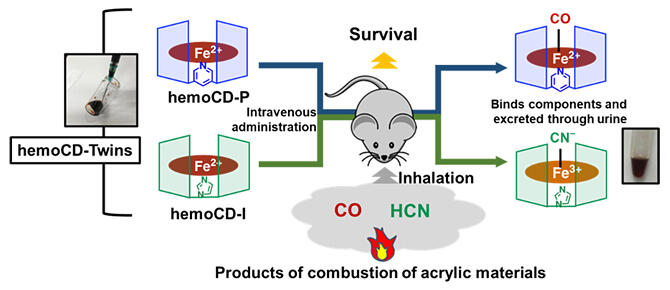Professor Hiroaki Kitagishi of the Faculty of Science and Engineering at Doshisha University, in collaboration with Doshisha Women's College of Liberal Arts, Tokai University, the Building Research Institute and Université Paris‐Est Créteil in France, has developed 'hemoCD‐Twins,' a candidate therapeutic compound to overcome simultaneous carbon monoxide (CO) and hydrogen cyanide (HCN) poisoning. It consists of heme iron and cyclodextrin dimers, two compounds that function in the blood that strongly capture CO and HCN respectively and can be prepared by simply mixing the powders. It is very stable and can be stored for long periods in powder and aqueous solution. Experiments with simultaneous CO and HCN poisoning mice confirmed a survival rate of 85% or higher (0% survival rate for those not administered the compound). The results are expected to lead to the development of special drugs that can treat gas poisoning caused by fire. The group's research was published in the 21 February issue of PNAS, Proceedings of the National Academy of Sciences.

Provided by Doshisha University
Building fires not only cause disorders due to thermal injuries, but also produce highly lethal toxic gases such as CO and HCN, which cause poisoning, but there are currently no remedies available as an antidote to them. Hyperbaric oxygen therapy (HBO) is available to treat CO poisoning but requires being transported to a hospital and the equipment is only available in a limited number of hospitals.
To date, the research group has been involved in biomimetics research, using living organisms as models for the production of functional substances. In 2021, they applied research on artificial hemoglobin to develop hemoCD‐P, which functions at room temperature and in water and has a higher CO‐binding capacity than any protein in vivo. They found that when administered to CO poisoning mice, the CO not only in the whole body but also in the brain was quickly captured and excreted in the urine, thereby reducing it. In their research, the group synthesized a similar hemoCD‐I, which differs in structure in part from hemoCD‐P, and administered it to mice and found that hemoCD‐P is excreted as ferrous whereas hemoCD‐I is excreted as ferric iron(III), showing a difference in oxidizability.
They studied the possibility of capturing and removing highly toxic HCN from the body as CO binds only to divalent iron and HCN to trivalent iron. They examined the ability of 'hemoCD‐Twins,' a mixture of both compounds, to excrete two gas components, CO and HCN, in a single dose.
Firstly, mice poisoned with both CO and cyanide were created by having the mice inhale CO gas after being given sodium cyanide. They compared survival rates and other factors between the 'hemoCD‐Twins' and non‐treated groups. Then, the researchers found simultaneous poisoning of CO and cyanide to be more dangerous, as each was fatal even at sub‐lethal doses.
In addition, the 'hemoCD‐Twins' group also showed a dose‐dependent increase in survival, with 85% surviving at the maximum dose, while all non‐treated mice died within one hour. When they examined the recovery behavior of the mice, the blood pressure of the poisoned mice, which had fallen with poisoning, recovered rapidly with administration, and the blood levels of CO and cyanide decreased over time.
They also confirmed that the administered 'hemoCD‐Twins' bind toxic components and are 100% excreted in the urine within about two hours and do not remain in body tissues.
Moreover, the researchers conducted further experiments in which mice were actually exposed to combustion gases containing CO and HCN and administered 'hemoCD‐Twins.' Exposure to the combustion gas stopped all behavior of the mice within five minutes, and at this stage the survival rates of the treated and non‐treated groups were compared.
The results showed a survival rate of 80% or higher for the treated group and about 40% for the non‐treated group. The surviving mice in the treated group regained consciousness immediately after administration and behaved similarly to healthy mice.
'HemoCD‐Twins' can be prepared by simply mixing the four powders with saline. All of the powders are stable and can be stored for a long time. The treatment can be easily prepared at the scene of a fire and is intended to be used by doctors who attend to a scene in ta rapid response car or other vehicle who can give treatment with an intravenous drip.
The group will now consider mass synthesis for safety trials and work with emergency medicine clinicians to gain regulatory approval.
"Because it can be applied to single or mixed gas poisoning, we hope that it will be possible to administer it immediately on site," said Kitagishi. "We hope that it will help prepare society for so‐called unpredictable calamities, such as large‐scale disasters and terrorism, for example."
Journal Information
Publication: PNAS
Title: A synthetic porphyrin as an effective dual antidote against carbon monoxide and cyanide poisoning
DOI: 10.1073/pnas.2209924120
This article has been translated by JST with permission from The Science News Ltd. (https://sci-news.co.jp/). Unauthorized reproduction of the article and photographs is prohibited.




